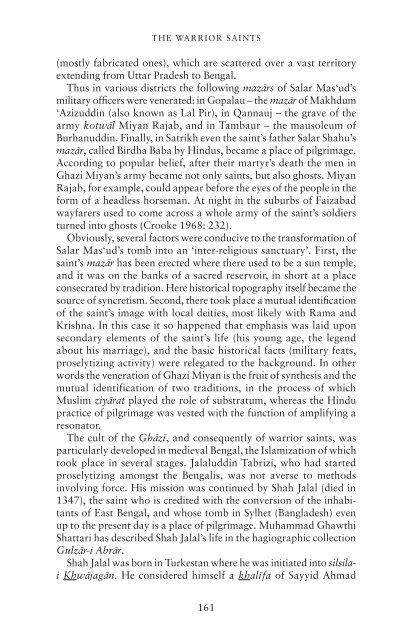Muslim Saints of South Asia: The eleventh to ... - blog blog blog
Muslim Saints of South Asia: The eleventh to ... - blog blog blog
Muslim Saints of South Asia: The eleventh to ... - blog blog blog
Create successful ePaper yourself
Turn your PDF publications into a flip-book with our unique Google optimized e-Paper software.
THE WARRIOR SAINTS<br />
(mostly fabricated ones), which are scattered over a vast terri<strong>to</strong>ry<br />
extending from Uttar Pradesh <strong>to</strong> Bengal.<br />
Thus in various districts the following mazārs <strong>of</strong> Salar Mas‘ud’s<br />
military <strong>of</strong>ficers were venerated: in Gopalau – the mazār <strong>of</strong> Makhdum<br />
‘Azizuddin (also known as Lal Pir), in Qannauj – the grave <strong>of</strong> the<br />
army kotwāl Miyan Rajab, and in Tambaur – the mausoleum <strong>of</strong><br />
Burhanuddin. Finally, in Satrikh even the saint’s father Salar Shahu’s<br />
mazār, called Birdha Baba by Hindus, became a place <strong>of</strong> pilgrimage.<br />
According <strong>to</strong> popular belief, after their martyr’s death the men in<br />
Ghazi Miyan’s army became not only saints, but also ghosts. Miyan<br />
Rajab, for example, could appear before the eyes <strong>of</strong> the people in the<br />
form <strong>of</strong> a headless horseman. At night in the suburbs <strong>of</strong> Faizabad<br />
wayfarers used <strong>to</strong> come across a whole army <strong>of</strong> the saint’s soldiers<br />
turned in<strong>to</strong> ghosts (Crooke 1968: 232).<br />
Obviously, several fac<strong>to</strong>rs were conducive <strong>to</strong> the transformation <strong>of</strong><br />
Salar Mas‘ud’s <strong>to</strong>mb in<strong>to</strong> an ‘inter-religious sanctuary’. First, the<br />
saint’s mazār has been erected where there used <strong>to</strong> be a sun temple,<br />
and it was on the banks <strong>of</strong> a sacred reservoir, in short at a place<br />
consecrated by tradition. Here his<strong>to</strong>rical <strong>to</strong>pography itself became the<br />
source <strong>of</strong> syncretism. Second, there <strong>to</strong>ok place a mutual identification<br />
<strong>of</strong> the saint’s image with local deities, most likely with Rama and<br />
Krishna. In this case it so happened that emphasis was laid upon<br />
secondary elements <strong>of</strong> the saint’s life (his young age, the legend<br />
about his marriage), and the basic his<strong>to</strong>rical facts (military feats,<br />
proselytizing activity) were relegated <strong>to</strong> the background. In other<br />
words the veneration <strong>of</strong> Ghazi Miyan is the fruit <strong>of</strong> synthesis and the<br />
mutual identification <strong>of</strong> two traditions, in the process <strong>of</strong> which<br />
<strong>Muslim</strong> ziyārat played the role <strong>of</strong> substratum, whereas the Hindu<br />
practice <strong>of</strong> pilgrimage was vested with the function <strong>of</strong> amplifying a<br />
resona<strong>to</strong>r.<br />
<strong>The</strong> cult <strong>of</strong> the Ghāzī, and consequently <strong>of</strong> warrior saints, was<br />
particularly developed in medieval Bengal, the Islamization <strong>of</strong> which<br />
<strong>to</strong>ok place in several stages. Jalaluddin Tabrizi, who had started<br />
proselytizing amongst the Bengalis, was not averse <strong>to</strong> methods<br />
involving force. His mission was continued by Shah Jalal (died in<br />
1347), the saint who is credited with the conversion <strong>of</strong> the inhabitants<br />
<strong>of</strong> East Bengal, and whose <strong>to</strong>mb in Sylhet (Bangladesh) even<br />
up <strong>to</strong> the present day is a place <strong>of</strong> pilgrimage. Muhammad Ghawthi<br />
Shattari has described Shah Jalal’s life in the hagiographic collection<br />
Gulzār-i Abrār.<br />
Shah Jalal was born in Turkestan where he was initiated in<strong>to</strong> silsilai<br />
Khwājagān. He considered himself a khalīfa <strong>of</strong> Sayyid Ahmad<br />
161


